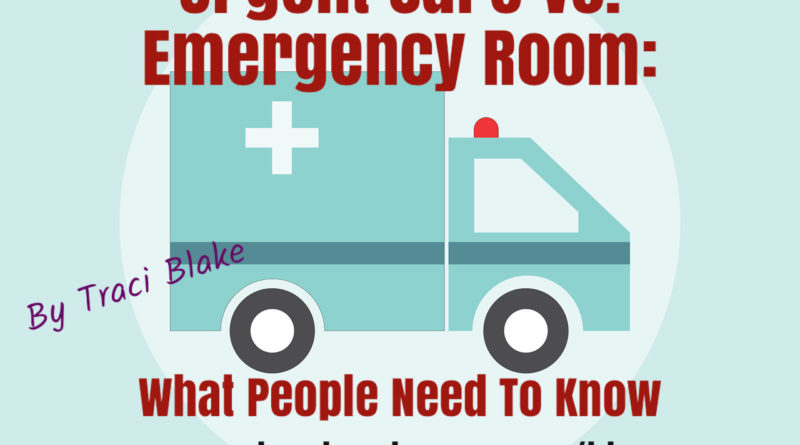Urgent Care vs. Emergency Room: What People Need To Know


The right place for the right care: Urgent care vs. emergency room
It’s 7 pm on a Friday night when you hear what sounds like a tumble or fall, followed by a loud shriek. Your five-year-old is crying, holding his wrist. It appears to be injured or, worse still, fractured.
You know your child needs immediate care – and your doctor’s office is closed. Where do you go for the care your little one needs?
In the past year, the Centers for Disease Control (CDC) estimates that 93.6% of children had contact with a health care professional. Most of these cases were for preventive care and regular checkups. But many visits were for illnesses or injuries – which are generally unexpected, out of our control and may occur after regular office hours.
Urgent care centers and emergency rooms are among the most commonly used places for treating injuries and illnesses. The trouble is, when your child is crying and you’re in a hurry to make a decision, it’s a difficult time to consider the difference between the two. While they share similarities, emergency rooms and urgent care centers are not the same.

Let’s explore the differences.
Emergency Room: For serious, life-threatening problems
The emergency room (ER) is set up to treat serious injuries and life-threatening medical issues. From board-certified emergency room physicians and skilled nurses to sophisticated trauma rooms, labs and imaging equipment, the ER is a high-tech and high-performing marvel. But it isn’t the best place to handle every bump, bruise, cut, burn and cough that comes through its doors. And when less serious conditions land in the emergency room, the time you wait to receive care may be longer as more serious medical emergencies are treated first.
In the most recent version of the National Hospital Ambulatory Medical Care Survey, the CDC found that 136.9 million people visited emergency departmentsin the United States last year. Of those visits, only 12.3 million – or 9% – were admitted to the hospital. While many of these visits were necessary, most experts agree a large percentage of patients could be treated elsewhere. Yet because ERs are open around-the-clock, every day of the year, consumers still use them for any after-hours medical care.
What types of illnesses or injuries warrant a visit to the emergency room? An ER visit is recommended for any serious and life-threatening illnesses or injuries, including:
- Head injuries
- Auto accidents
- Falls that may involve multiple injuries
- Severe allergic reactions
- Uncontrollable or severe bleeding
- Loss of consciousness or vision
- Chest pains and breathing difficulty
- Stroke symptoms
- Mental illness concerns
These medical issues can be life-threatening and should be treated as emergencies as quickly as possible. If you or a loved one experiences symptoms of a heart attack, stroke or other potentially life-threating injury, you should always call 9-1-1 first, rather than try to drive to the ER.
Urgent Care Services: Your best option for minor illnesses and injuries
Urgent care clinics treat minor illnesses and injuries. But they’re not intended for serious injuries or illnesses, or any condition that may be life-threatening. This line can be blurry, so here are a few things urgent care centers commonly treat:
- Minor fractures, sprains, strains
- Minor bumps, scrapes, rashes, cuts, stitches, burns, etc.
- Fever, cough, sore throat, ear/sinus pain, general cold/flu symptoms
- Nausea, vomiting, diarrhea
- Seasonal allergies, eye irritation, mild asthma
- Basic lab tests such as flu or strep tests
Because urgent care centers focus on non-life-threatening symptoms, they generally keep standard business hours. Indigo Urgent Care, for example, is open 8 am to 8 pm daily. Urgent care clinics accept walk-ins and most insurance policies, but shouldn’t be treated as an emergency room, 24-hour pharmacy or in-patient care unit.
And, since most urgent cares have a website, it’s always a good idea to check on hours, services and whether they accept your insurance, before you visit. Some urgent cares also offer a flat-fee for those who don’t have insurance.
Urgent cares also work hand-in-hand with area emergency rooms. If your condition is more serious or complex, you will be transferred to the closest emergency room.
Informed health care is better health care
When you or a loved one is sick or injured, it’s challenging to research options and know what’s best. That’s why we encourage you to check out where your local urgent care centers are located, what they treat (and what they don’t), hours and what insurance is accepted.
It’s also important to know where local emergency rooms are located. Be sure to review your insurance coverage for emergency room visits. Some insurance plans charge a premium for using the emergency room for minor illnesses such as the flu or an ear infection.
While none of us can prevent injury or illness, we can take preventive steps to know and understand what health care facilities are best suited for minor conditions – and when to seek emergency room treatment.
The above article is a guest post from Traci Blake of Indigo Urgent Care.






Urgent Care and the emergency room is not the same thing. Urgent care provides treatment for small injuries and illnesses. But the emergency room(ER) provides the treatment for serious or life-threatening injuries or illnesses. Walk In Clinic NY is one of the best clinics in New York that provide the best urgent care with certified doctors. If you live in New York and you need any kind of urgent care then you can go to this clinic. For an online appointment, you can visit this link – https://walk-in-clinic-ny.com